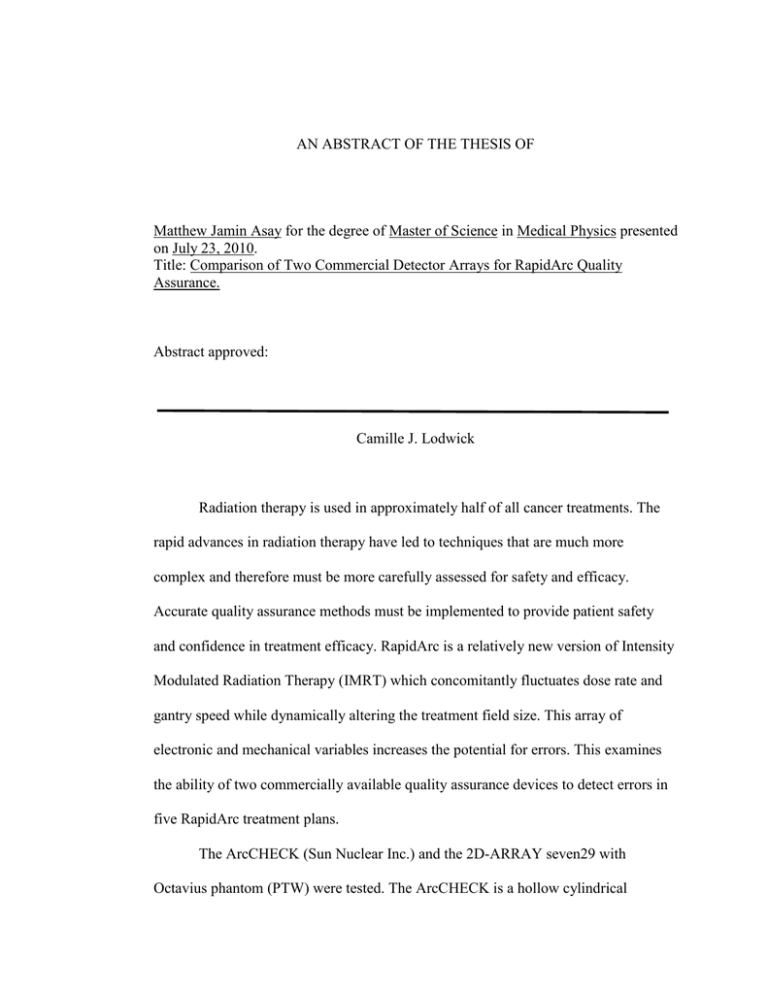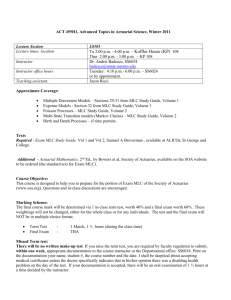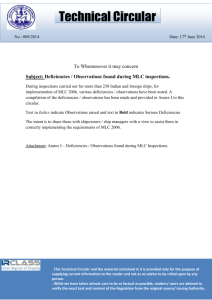AN ABSTRACT OF THE THESIS OF
advertisement

AN ABSTRACT OF THE THESIS OF Matthew Jamin Asay for the degree of Master of Science in Medical Physics presented on July 23, 2010. Title: Comparison of Two Commercial Detector Arrays for RapidArc Quality Assurance. Abstract approved: Camille J. Lodwick Radiation therapy is used in approximately half of all cancer treatments. The rapid advances in radiation therapy have led to techniques that are much more complex and therefore must be more carefully assessed for safety and efficacy. Accurate quality assurance methods must be implemented to provide patient safety and confidence in treatment efficacy. RapidArc is a relatively new version of Intensity Modulated Radiation Therapy (IMRT) which concomitantly fluctuates dose rate and gantry speed while dynamically altering the treatment field size. This array of electronic and mechanical variables increases the potential for errors. This examines the ability of two commercially available quality assurance devices to detect errors in five RapidArc treatment plans. The ArcCHECK (Sun Nuclear Inc.) and the 2D-ARRAY seven29 with Octavius phantom (PTW) were tested. The ArcCHECK is a hollow cylindrical phantom with diodes placed in a spiral array. The PTW device is a flat panel of ion chambers positioned within an octagonal phantom. Both devices were tested for linearity over a range of 1-300 MU of 6 MV photons delivered via a static 10x10 cm2 field. To assess the sensitivity of the devices in a treatment scenario, errors were introduced including couch rotations, gantry position errors and shifts in the multi-leaf collimator (MLC). Couch rotations of 0.5°-5° were induced and unaltered treatment plans were then delivered to the two devices. Errors in gantry rotation and MLC leaf positions were introduced via a Matlab program that modifies existing DICOM treatment files in a predetermined manner. Gantry errors ranged from 0.5°-5°. MLC errors included systematic shifts, systematic opening and closing and random leaf errors of 10% or 20%. The magnitude of MLC errors ranged from 0.25-5mm. Results were analyzed using the gamma analysis method. Both devices demonstrated linearity within 1% for a static 10x10 cm2 field. The ArcCHECK detected a couch rotation of 2° or less in all plans and the PTW detected a couch rotation of 4° or less in the frontal plane and only detected an error in a head and neck plan when measured in the sagittal plane. However, both devices responded with less sensitivity when subjected to gantry rotation errors. The ArcCHECK was more reliable at detecting MLC errors and demonstrated an overall higher sensitivity to errors than the PTW system. A study of the effect of these errors on dose distribution in tumor treatment volumes and organs at risk would be a logical next step. ©Copyright by Matthew Jamin Asay July 23, 2010 All Rights Reserved COMPARISON OF TWO COMMERCIAL DETECTOR ARRAYS FOR RAPIDARC QUALITY ASSURANCE by Matthew Jamin Asay A THESIS submitted to Oregon State University in partial fulfillment of the requirements for the degree of Master of Science Presented July 23, 2010 Commencement June 2011 Master of Science thesis of Matthew Jamin Asay presented on July 23, 2010. APPROVED: Major Professor, representing Medical Physics Head of the Department of Nuclear Engineering and Radiation Health Physics Dean of the Graduate School I understand that my thesis will become part of the permanent collection of Oregon State University libraries. My signature below authorizes release of my thesis to any reader upon request. Matthew Jamin Asay, Author ACKNOWLEDGEMENTS I would like to thank my advisor, Dr. Camille Lodwick for her assistance throughout my graduate program. She got the project rolling and gave me support and encouragement during the process. Her assistance in finding funding for my studies is most appreciated. I would like to thank Dr. Todd Palmer for letting me use his car for my travel to OHSU to perform this research. Completion of this project would have been much more difficult without his generous support. In addition, he was a great help in getting the Matlab program running. I would like to thank Dr. Wolfram Laub for his assistance with my research. Dr. Laub provided much support in designing and analyzing my experiments and in providing the PTW device as well as time on the linear accelerators at OHSU. I would like to thank Dr. Junan Zhang, Dr. James Tanyi and Dr. Tony He for their help during my research time at OHSU. I would like to thank Sun Nuclear Inc. for providing the ArcCHECK device and for advice on how to use it correctly. My wife Elaina, and my three children, Ethan, Aurora and Emmeline deserve the most thanks for their patience with me through another graduate degree. They have made many sacrifices as I spent many hours away from home for my research and studies. TABLE OF CONTENTS Page Introduction…………………………………………. 1 Intensity Modulated Radiation Therapy…….. 1 Quality Assurance Devices………………….. 2 RapidArc Error Propagation………………… 8 Research Aim……………………………….. 10 Materials and Methods……………………………… 11 Results………………………………………………. 15 Device Characterization…………………….. 15 Couch Rotation……………………………... 17 Gantry Angle Errors………………………… 18 MLC Errors…………………………………. 20 Discussion and Conclusion…………………………. 26 Bibliography………………………………………… 30 LIST OF FIGURES Figure Page 1. ArcCHECK device from Sun Nuclear Inc…………………5 2. PTW 2D-ARRAY seven29 with Octavius phantom…….....5 3. Picture and schematic of a SunPoint Diode detector………6 4. Detector linearity compared to expected value……………15 5. Dose linearity percent error ± SD using equation 1..............16 6. Dose linearity percent error ± SD using equation 2..............16 7. Couch rotation detection by ArcCHECK…………………..17 8. Couch rotation detection by Octavius array in the frontal plane………………………………………………...17 9. Couch rotation detection by Octavius array in the sagittal plane………………………………………………..18 10. ArcCHECK measurements after inducing gantry angle errors………………………………………………………..18 11. Octavius measurements with the array in frontal plane after inducing gantry angle errors…………………………..19 12. Octavius measurements with the array in sagittal plane after inducing gantry angle errors…………………………..19 13. Examples of MLC fields after being altered by MatLab program……………………………………………………..20 14. Detector pass rates for ArcCHECK measurements after introducing MLC systematic shift errors……………………21 LIST OF FIGURES (Continued) Figure Page 15. Detector pass rates for Octavius measurements in frontal plane after introducing MLC systematic shift errors…………………………………………………..21 16. Detector pass rates for Octavius measurements in sagittal plane after introducing MLC systematic shift errors…………………………………………………..22 17. Detector pass rates for ArcCHECK measurements after introducing MLC open errors……………..………………..23 18. Detector pass rates for Octavius measurements in frontal plane after introducing MLC open errors...………...23 19. Detector pass rates for Octavius measurements in sagittal plane after introducing MLC open errors...………..24 20. Pass rates for all three detectors for a hip patient after introducing systematic close errors………………………...24 21. Pass rates for all three detectors for a hip patient after introducing random errors to 10% of active leaves………...25 22. Pass rates for all three detectors for a hip patient after introducing random errors to 20% of active leaves………...25 COMPARISON OF TWO COMMERCIAL DETECTOR ARRAYS FOR RAPIDARC QUALITY ASSURANCE Chapter 1 INTRODUCTION Radiation therapy is used as a treatment modality in approximately half of all cancer cases.1 The effectiveness of radiation therapy as a curative or palliative technique naturally drives technological advancements at a rapid pace. These developments potentially improve the accuracy and effectiveness of the treatment, but they also increase the complexity, requiring more thorough evaluation of treatment plans prior to delivery. Recent high profile reports tell of injuries and deaths resulting from errors in treatment planning or delivering radiation therapy. These reports highlight the need for vigilance in the execution of radiation prescriptions.2 Intensity Modulated Radiation Therapy Routine use of intensity modulated radiation therapy (IMRT) has escalated rapidly over the past decade. IMRT is generally delivered from several fixed beam angles in order to create a more conformal dose distribution in order to spare surrounding healthy tissue. Through the use of multi-leaf collimators (MLCs), IMRT creates multiple fields, or beamlets, within a fluence plane resulting in a temporally modulated dose to the target and surrounding tissue.3 Volumetric modulated arc therapy (VMAT), a form of IMRT with the gantry in constant motion, has been implemented in the past few years. VMAT can 2 potentially deliver a radiation field that better conforms to the tumor volume while reducing treatment time. This advancement is possible due to the ability of VMAT to modulate dose rate and gantry speed while the MLC adjusts the shape of the field, creating more opportunities for optimization.4 Since the radiation is distributed over one or more arcs, the dose to healthy tissue is spread across a much larger volume. Additionally, the gantry rotation allows dose to be reduced in areas that penetrate sensitive organs while increasing the dose that passes through less sensitive tissue. RapidArc is the name of the commercially available version of VMAT from Varian. RapidArc planning uses progressive sampling by adding groups of control points during optimization. As the optimization advances, the MLC leaves are restricted to smaller movements and the gantry angles are sampled at a finer resolution. The number of control points is doubled at each level of resolution until the final number achieved is 177 per arc.4-6 This results in a control point approximately every 2° of gantry rotation in the final plan. Quality Assurance Devices IMRT treatments are comprised of many small beamlets that are combined into a planar fluence distribution. Because of this, each treatment plan must be evaluated with treatment planning software as well as on the linear accelerator before being delivered to the patient.7 The delivery of RapidArc plans is much more complicated than 3-D conformal or IMRT treatments due to the dynamic motion of the gantry and MLC as well as the modulated dose rate. Therefore, patient-specific quality assurance 3 (QA) of RapidArc plans is even more critical. Historically, IMRT QA was performed with film or ion chamber point dose measurements 8, but in recent years, most clinics have moved to a dosimetric phantom for their measurements.9, 10 In order to perform QA on a fixed gantry IMRT plan, the planar dose is calculated in the treatment planning system and the beamlets are delivered with the gantry perpendicular to the dosimeter. These phantoms are generally a 2-D plane of detectors, which work fine for fixed gantry IMRT, but may be less well suited for rotational IMRT.8, 11, 12 The rotational nature of RapidArc creates a complex problem for quality assurance compared to static IMRT. Since the fluence from the linac is integrated with the position of the treatment head, proper QA cannot be performed statically. The necessity for the gantry to be in motion during beam delivery raises questions about the accuracy of planar QA devices. Since these devices were developed to measure beams perpendicular to their surface, rotating the beam around the device introduces the possibility of errors due to the angular dependency of detectors and heterogeneity of the dosimeter when viewed from a non-normal direction. In addition, much of the dose modulation information is lost when the angle of incidence of the beam changes from perpendicular to parallel.13 These issues suggest a more complex phantom geometry may be needed to achieve accurate volumetric dose measurements. In addition to geometric variables, two different detector types are typically used in QA devices. The gold standard for dose measurements is the ion chamber. Semi-conducting diodes are another common option. Each type of detector has tradeoffs that must be considered when choosing a device for QA measurements. 4 Ion chambers are the recommended radiation measurement device for radiation dosimetry due to their stability and accuracy.14 For patient QA, ion chambers are limited because their radiation sensitivity decreases proportionately as their volume decreases.15 Therefore, ion chambers must have a relatively large volume to accurately detect radiation. This leads to a phenomenon called dose volume averaging.16 Ion chambers actually record the average dose collected by the entire volume, which can pose a problem in high dose gradient regions of a radiation field.17 Also, the dosimetry system has leakage that is constant regardless of which ion chamber is used, so a smaller ion chamber will have a relatively larger error associated with it.18 Diodes are another common radiation detector. Semi-conducting diodes are often used because of their small size and extreme sensitivity. Silicon is 18000 times more dense than air, allowing diodes to be thousands of times smaller than an ion chamber and still be much more sensitive. Diodes have been shown to be temperature, dose rate and energy dependent and sensitive to radiation damage.19-25 The two devices investigated in this study are the ArcCHECK (AC; Figure 1) from Sun Nuclear Inc. and the 2D-ARRAY seven29 with the Octavius phantom from PTW (PTW; Figure 2). 5 Figure 1: ArcCHECK device from Sun Nuclear Inc. Figure 2: PTW 2D-ARRAY seven29 with Octavius phantom. The AC is a hollow cylinder with a spiral array of 1386 diodes. The diodes are placed between two layers of solid water or acrylic and spaced 1 cm apart.11 The proprietary n-type diodes (Sun Point) are designed to be resistant to radiation 6 damage.26 The SunPoint diodes have a surface area of 0.64 mm2 and a volume of 0.000019 cm3 (Figure 3). Figure 3: Picture and schematic of a SunPoint Diode detector 22. Since the AC is a relatively new device, there are not many publications to detail its performance.11 However, the same SunPoint diodes are used in Sun Nuclear’s MapCHECK device which is typically used for static gantry IMRT QA. Several authors have performed tests that apply to the general performance of the AC diodes regarding stability. In one study, the central diode of the MapCHECK device was irradiated with increasing doses and the response was linear.9, 10, 26 The dose rate dependence of the diodes was found to be much less than older n-type diodes, and 7 similar to p-type diodes over a 600 fold change in dose rate.26 Short term reproducibility over a period of minutes to hours was approximately ±0.15%.9, 10 During a one month period, diode variation was approximately 1%.10 In another study over a several month period, the diode readings varied by ±0.2%.26 A temperature dependence of 0.57%/°C 9 or 0.54%/°C 26 was observed, which should be taken into account when measuring absolute dose. Tests of diode angular dependence on an ArcCHECK prototype found increased sensitivity of 8% when radiation was incident on the lateral surface and decreased sensitivity of 5% when irradiated from the bottom.12 The PTW system is composed of two parts, a flat ion chamber array and octagonal phantom.8 The dosimeter consists of a 27x27 array of ion chambers (729 total) spaced 1 cm center to center. The chambers have dimensions of 5x5x5 mm3 for a total volume of 0.125 cm3. The phantom is an octagon composed of polystyrene (1.04 g/cm2). There are two phantoms required for the PTW system, a CT phantom and a LINAC phantom. The patient plan is calculated using the CT scan of the solid CT phantom. Due to the under-response of the ion chamber array when irradiated from below, the LINAC phantom has a semi-circular air gap in the bottom half to correct for that problem and that phantom is used for the quality assurance measurements.8 Similar to the MapCHECK, the PTW 2D-Array seven29 has been used for IMRT QA for a few years and its performance has been evaluated. The short term reproducibility of a series of ten repeated measurements demonstrated a maximum 8 standard deviation of 0.2% and the long term reproducibility was within 1%.27 Over a dose range of 2-500 MU, the ion chamber output was linear.27 The prototype Octavius phantom was tested for rotational IMRT and it was found that the ion chamber reported values lower than the treatment planning system predictions by 8% for 6 MV beams and 4% for 18 MV beams when irradiated from the back.8 In order to correct this, an air chamber was inserted into the bottom of the commercial version of the phantom. RapidArc Error Propagation The dynamic nature of RapidArc, with its modulated dose rate, MLC leaf motion and gantry rotation can potentially increase error propagation dramatically when compared to static field IMRT techniques. Errors in any of these three parameters could decrease the accuracy of the treatment delivery. The magnitude of MLC leaf errors during RapidArc delivery increases linearly with leaf speed.6 At a leaf speed of 2.76 cm/s, 87% of the leaves were within 0.5 mm, 7% were within 0.51.0 mm, 4% were within 1.0-1.5 mm, 2% were greater than 1.5 mm and none were greater than 2.5 mm of their expected position as determined by the treatment planning software.6 The effect of these errors on dose distribution in the treatment plan was not measured. A few studies have investigated the effects of MLC errors on dose distribution in treatment volumes for IMRT plans. A simulation study showed that random MLC errors of up to 2 mm resulted in negligible changes while systematic errors of up to 1 9 mm led to potentially significant changes in dose deposited for head and neck cancer treatment plans.28 Mu investigated the impact of random and systematic leaf errors of up to 2 mm in simple and complex head and neck cancer plans.29 Their findings indicate that random errors had no effect but systematic errors caused significant dosimetric differences in the target volume, spinal cord and parotid glands. Luo indicated that systematic MLC errors resulted in a 5%/mm dose discrepancy in prostate plans.30 Most recently, Oliver et al. found that random MLC errors were insignificant, but systematic errors, especially MLC opening or closing errors potentially had a significant effect on dose deposited in the PTV.31 The effects ranged from 1.3%-4% of the prescription. Tolerance levels of the QA measurements required for the acceptance process of an IMRT treatment plan do not have clear, universal parameters. Individual clinics have their own techniques and policies to determine whether an IMRT treatment plan is safe to deliver to a patient.32 One study of these parameters recommended using a 3%/3mm gamma analysis method with cutoffs of 95% pass rate for non-head and neck and 88% for head and neck IMRT cases.32 RapidArc is an even newer and more complex technology, so the parameters that should be used for QA testing are even less well understood. Research Aim This research will address the following question: 10 --Does the ArcCHECK or the Octavius system demonstrate superior performance when identifying errors introduced in gantry angle, setup (couch orientation) or MLC leaf errors? 11 Chapter 2 MATERIALS AND METHODS All treatment beams were delivered by a Varian Clinac 600 radiotherapy linear accelerator. Both the ArcCHECK and Octavius phantoms were positioned with the assistance of a bubble level and laser crosshair alignments in both the coronal and sagittal planes at isocenter. Absolute dose calibration was performed following the manufacturer’s instructions for the ArcCHECK device. The Octavius system was calibrated at the factory. The Octavius system was warmed up before each measurement session for at least 15 minutes and then a cross calibration was performed by delivering 161 MU with a 6 MV beam and 10x10 cm2 field size. The calibration was accepted if the absolute dose to the central chamber was 1 Gy +/- 2%. The linearity of detector response was measured by delivering varying amounts of radiation (1-300 MU) with a 6 MV beam with a 10x10 cm2 field size. The beams were delivered five times. The reading from the central chamber of the Octavius array was compared to the expected reading. The ArcCHECK device does not have a central diode, so the average of the two most central diodes was compared to the expected reading. Fluctuations in the measured dose [ were calculated in two ways as shown below10 (1) (2) 12 where and respectively, and are the measured values at M MU and 300 MU and are the average reading of all measurements at M MU and 300 MU respectively. The standard deviation of the percent errors was also calculated. A reliable quality assurance device must also be able to detect setup errors in couch orientation. Unaltered treatment plans were measured after rotating the treatment couch between 0.5° and 5° from the origin. In order to determine the ability of the dosimeters to detect errors in treatment plans during QA measurements, a computer program was utilized to introduce errors into the plans. Several clinical RapidArc plans (2 prostate, 2 head and neck, 1 hip) were examined in this study. The different anatomical locations were chosen to provide a variety of complexity with the hip plan being the simplest and the head and neck the most complex. Treatment plans were exported from Eclipse (Varian Medical Systems, Palo Alto, USA) as DICOM files and opened with a Matlab (v7.9.0.529, Mathworks Inc., Natick, USA) based program provided by the BC Cancer Agency.31 This program imports DICOM plan files and modifies active MLC leaf positions or gantry angles. Any leaf that moves during treatment and has a position that is not the same as the opposing leaf for at least one control point is considered active.31 The program was employed to introduce MLC leaf or gantry angle errors of various types and magnitudes into the DICOM files as described below. MLC leaf errors can be classified as systematic or random. Systematic errors include shifting both leaf banks in either the same or opposite directions. Shifting both 13 leaf banks in the same direction results in moving the MLC aperture off-center while shifting both MLC banks in opposite directions results in either opening or closing the MLC aperture. Random errors were simulated by sampling a Gaussian function with a standard deviation equal to the error magnitude prescribed.31 For this study, either 10% or 20% of the active leaves were randomly shifted by the software. The magnitude of the induced MLC leaf errors ranged from 0.25 to 5 mm. Gantry angle errors were introduced in a systematic manner and ranged from 0.5° to 5°. Not all error types or magnitudes were implemented for every treatment plan tested. A table showing which tests were performed and range of the error for each treatment location is shown in Table 1. Table 1: Specific magnitudes for induced errors Plan type Hip (1 patient) Prostate (2 patients) Head and Neck (2 patients) Gantry Error (°) Systematic Shift (mm) Systematic Open (mm) Systematic Close (mm) 10-20% Random leaves (mm) 0.5-5 0.25-5 0.25-5 0.25-5 0.25-5 0.5-1 0.25-5 0.25-5 N/A N/A 0.5-1 0.25-5 0.25-5 N/A N/A Since the Octavius system has a flat panel of ion chambers, all plans were measured with the face of the array parallel to the treatment couch (frontal plane) as well as with the array perpendicular to the treatment couch (sagittal plane). The ArcCHECK is a cylinder, so no rotation was necessary. 14 Measurements were compared to the dose calculations exported from Eclipse using MapCHECK software for the ArcCHECK device and VeriSoft for the Octavius system. The data were compared using the gamma analysis technique with a 3%/3 mm setting.33, 34 The formula used for gamma analysis is: where r is the spatial distance between evaluated and reference dose points, d is the distance to agreement criterion (3 mm), is the difference between the measured dose and the expected dose and D is the dose difference criterion (3%). When is less than or equal to 1, the point being evaluated passes. When is greater than 1, the point being evaluated fails. The software reports the percentage of detectors that pass the gamma analysis. For this study, an error will be considered “detected” by each device if the pass rate is <90%. 15 Chapter 3 RESULTS Device Characterization The linearity of the two devices when compared to the delivered MU is shown in Figure 4. All measurements of 5 MU or more using the ArcCHECK were within 0.25% while the maximum deviation for the Octavius system was 1.1%. Both detectors showed an under response at 20 MU or above and an over response at 1 and 5 MU. Device reading (MU) 300.00 250.00 200.00 150.00 Octavius 100.00 ArcCHECK 50.00 Expected 0.00 1 5 20 50 100 200 300 Delivered Monitor Units Figure 4: Detector linearity compared to expected value. The percent error calculated using equations 1 and 2 are shown in Figures 5 and 6. The percent error from equation 1 results in Octavius having a larger error than ArcCHECK with both detectors displaying an under response above 5 MU (Figure 5). The percent error for both detectors is nearly zero when calculated in reference to the 16 respective 300 MU measurements for each device with a decreasing standard deviation as the dose increases (Figure 6). 6.0 ArcCHECK Octavius Percent Error 4.0 2.0 0.0 -2.0 -4.0 0 50 100 150 200 MU Delivered 250 300 Figure 5: Dose linearity percent error +/- SD using equation 1. 1.5 ArcCHECK Octavius Percent Error 1 0.5 0 -0.5 -1 -1.5 0 50 100 150 200 MU Delivered 250 300 Figure 6: Dose linearity percent error +/- SD using equation 2. 17 Couch Rotation The ArcCHECK detected a couch rotation of 0.5° in H&N 1 and a 2° rotation in the rest of the plans (Figure 7). The PTW array in the frontal plane detected a couch rotation of 2° in H&N 1, a 3° rotation in three other plans and a 4° rotation in the hip patient (Figure 8). The PTW array in the sagittal plane detected a couch rotation of 3° Detector Pass Rate (%) in H&N 2 but did not detect the error in any of the other plans (Figure 9). 100 90 80 70 60 50 40 30 Prostate 1 Prostate 2 H&N 1 H&N 2 0 1 2 3 4 5 Hip Couch Rotation (°) Detector Pass Rate (%) Figure 7: Couch rotation detection by ArcCHECK. 100 90 Prostate 1 80 Prostate 2 70 H&N 1 H&N 2 60 0 1 2 3 4 5 Hip Couch Rotation (°) Figure 8: Couch rotation detection by Octavius array in frontal plane. Detector Pass Rate (%) 18 100 95 Prostate 1 90 Prostate 2 85 H&N 1 H&N 2 80 0 2 Hip 4 Couch Rotation (°) Figure 9: Couch rotation detection by Octavius array in sagittal plane. Gantry Angle Errors Neither device was very successful at identifying errors in the gantry angle. The ArcCHECK detected a 0.5° shift in prostate patient 1 and a 5° shift in the hip patient (Figure 10). The Octavius system never dropped below a 93% pass rate when measuring plans in the frontal plane and only detected a gantry error in the hip plan at Detector Pass Rate (%) 5° in the sagittal orientation (Figures 11 and 12). 100 90 80 70 60 50 40 30 Prostate 1 Prostate 2 H&N 1 H&N 2 0 1 2 3 4 5 Hip Gantry error (°) Figure 10: ArcCHECK measurements after inducing gantry angle errors. 19 Detector Pass Rate (%) 100 98 Prostate 1 96 Prostate 2 94 H&N 1 92 H&N 2 90 Hip 0 1 2 3 4 5 Gantry error (°) Figure 11: Octavius measurements with the array in frontal plane after inducing gantry angle errors. Detector Pass Rate (%) 100 95 Prostate 1 90 Prostate 2 H&N 1 85 H&N 2 80 Hip 0 1 2 3 4 5 Gantry error (°) Figure 12: Octavius measurements with the array in sagittal plane after inducing gantry angle errors. 20 MLC Errors Examples of the MLC fields created by the MatLab program after inducing errors in the treatment plans are shown in Figure 13. Unaltered Plan Systematic Close Systematic Shift Systematic Open Random Leaves (20%) Figure 13: Examples of MLC fields after being altered by MatLab program. The ArcCHECK successfully detected a 1 mm MLC systematic shift in prostate 1 and detected a 5 mm systematic shift in the rest of the plans (Figure 14). A 0.5 mm error was detected in H&N 1, but the pass rate went above 90% when the error increased until a 5 mm shift occurred. The PTW device in the frontal orientation did not identify the systematic shift in any of the plans until a 5mm shift was reached (Figure 15). The PTW device detected a 2 mm shift in the H&N patients and a 5 mm shift in the hip and prostate 1 patient (Figure 16). An error in prostate 2 was never detected in this orientation. 21 Detector Pass Rate (%) 100 90 80 Prostate 1 70 60 Prostate 2 50 H&N 1 40 H&N 2 30 Hip 0 1 2 3 4 5 MLC error (mm) Figure 14: Detector pass rates for ArcCHECK measurements after introducing MLC systematic shift errors. Detector Pass Rate (%) 100 95 90 Prostate 1 85 Prostate 2 80 H&N 1 75 H&N 2 70 Hip 0 1 2 3 4 5 MLC error (mm) Figure 15: Detector pass rates for Octavius measurements in frontal plane after introducing MLC systematic shift errors. 22 Detector Pass Rate (%) 100 90 Prostate 1 80 Prostate 2 70 H&N 1 60 H&N 2 50 Hip 0 1 2 3 4 5 MLC error (mm) Figure 16: Detector pass rates for Octavius measurements in sagittal plane after introducing MLC systematic shift errors. The ArcCHECK detected a 0.5 mm gap in the H&N 1 field, a 1 mm gap in prostate 1 and H&N 2 fields and a 2 mm gap in the prostate 2 and hip fields (Figure 17). The PTW device in both the frontal and sagittal orientations detected a 1 mm gap in both prostate plans and H&N 1, a 2 mm gap in H&N2 and a 5 mm gap in the hip plan (Figures 18 and 19). 23 Detector Pass Rate (%) 100 80 Prostate 1 60 Prostate 2 40 H&N 1 20 H&N 2 0 Hip 0 1 2 3 4 5 MLC error (mm) Figure 17: Detector pass rates for ArcCHECK measurements after introducing MLC open errors. Detector Pass Rate (%) 100 80 Prostate 1 60 Prostate 2 40 H&N 1 20 H&N 2 0 Hip 0 1 2 3 4 5 MLC error (mm) Figure 18: Detector pass rates for Octavius measurements in frontal plane after introducing MLC open errors. 24 Detector Pass Rate (%) 100 80 Prostate 1 60 Prostate 2 40 H&N 1 20 H&N 2 0 Hip 0 1 2 3 4 5 MLC error (mm) Figure 19: Detector pass rates for Octavius measurements in sagittal plane after introducing MLC open errors. The QA performance results of systematically closing the MLCs for a hip patient are shown in Figure 20. The ArcCHECK detected a 1 mm error while the PTW system detected a 2 mm error in both planes. Detector Pass Rate (%) 100 80 60 ArcCHECK 40 Octavius Frontal Octavius Sagittal 20 0 1 2 3 4 MLC error (mm) Figure 20: Pass rates for all three detectors for a hip patient after introducing systematic close errors. 5 25 Pass rates of the same hip plan with introduced random MLC leaf error measurements are shown in Figures 21 and 22. Neither of the devices detected any errors for both the 10% and 20% randomization trials. Detector Pass Rate (%) 100 99 98 97 96 95 94 93 92 91 90 ArcCHECK Octavius Frontal Octavius Sagittal 0 1 2 3 MLC error (mm) 4 5 Detector Pass Rate (%) Figure 21: Pass rates for all three detectors for a hip patient after introducing random errors to 10% of active leaves. 100 99 98 97 96 95 94 93 92 91 90 ArcCHECK Octavius Frontal Octavius Sagittal 0 1 2 3 MLC error (mm) 4 5 Figure 22: Pass rates for all three detectors for a hip patient after introducing random errors to 20% of active leaves. 26 Chapter 4 DISCUSSION AND CONCLUSION Both devices exhibited a linear response, with measurements being within 1.1% or less for a static field. The standard errors calculated using either of the two different methods were very close to zero. The measurements would have more certainty if a reference ion chamber had been used to measure the linac output while the QA devices were being irradiated. Despite the lack of a direct measurement, errors are within the 2% limit for monthly linac QA measurements, so some of the error may be due to the linac output being lower than expected. One of the most striking results came from the couch rotation experiments. The ArcCHECK was able to detect a rotation of 2° or less in all of the treatment plans. The PTW system did not detect errors in all the plans until the couch reached 4° when measured in the frontal plane. The sagittal plane setup only detected a rotation in one plan. This shows that when performing quality assurance with the Octavius system, at least two planes must be measured to catch all error types. Assessment of gantry rotation errors, was limited by the number of data points that could be collected. The head and neck and prostate treatment plans consisted of two full arcs, while the hip plan was less than a full 360° arc. Shifts of more than 2° were not possible for the full arc plans because that would exceed the linac rotation limits. The ArcCHECK failed one prostate plan at 0.5° of gantry rotation error, with the rest of the plans approaching less than a 90% pass rate by 1°. Only the hip plan reached less than a 90% pass rate using the PTW system, and that did not occur until 27 there was a 5° error in the hip patient, although it was not possible to shift the rest of the plans this much. This result would seem to be a serious problem since so much care is taken to ensure that patient positioning and linac physical parameters are within millimeter tolerance levels. For the systematic shift errors, the ArcCHECK and the PTW (frontal plane) detected errors in all the plans by 5 mm, but the ArcCHECK detected a 1 mm error in a prostate plan. The PTW in the sagittal plane detected 2 mm errors in two plans, but was only able to catch errors in four of the plans by the time there was a 5 mm shift. For the systematic MLC open errors, the ArcCHECK detected errors in all of the plans with a 2 mm gap or less. The PTW system performed nearly identically in both planes. All plans failed with a 5 mm gap, four failed with a 2 mm gap and three failed with a 1 mm gap. The systematic MLC close and random MLC functions were only measured on the hip patient, as MLC errors were triggered on the linac when other patient plans were loaded into the machine. The ArcCHECK detected a 1mm closing of the MLC while the PTW system did not detect an error until the MLC was closed 2 mm. Neither detector reached below a 94% pass rate for the random leaf errors. The sensitivity of the QA devices seems to correlate with previous studies related to the actual dosimetric consequences of MLC errors. Random MLC errors cause little change in dose to treatment volumes in static field IMRT 28, 29, 35 and RapidArc plans.31 These results support the lack of significant change in detector passing rates for treatments plans measured with random MLC leaf errors. Systematic 28 shifts of the MLC banks also resulted in very little decrease in detector passing rates. Errors of this type were found to affect the dose distribution in RapidArc treatment volumes with a rate of -0.89 to 0.35 Gy/mm.31 In this study, the QA devices were most sensitive to the systematic open and close MLC errors. Similar results have been shown in other studies with static field IMRT 29 and RapidArc.31 Systematic open and close errors in RapidArc treatment volumes were found to vary by1.6 to 2.6 Gy/mm and -1.2 to -3.2 Gy/mm respectively.31 These correlations are a positive sign that the detector passing rates have some clinical significance to actual dose distributions. An unexpected result occurred in several of the tests. It is logical to assume that as errors are introduced into the plans, the pass rates would begin to decrease and continue to decrease as the error magnitude increases. In some cases, the pass rates increase as errors are introduced (see Figures 11, 12, 15, 16 and 17) or the pass rates begin to decrease as errors are introduced and then rise as the error magnitude is increased (Figure 14). This suggests that there might have been errors in the unaltered versions of the treatment plans or that the beam modeling in the treatment planning software could be improved. The phenomenon seems to occur more frequently in the head and neck cases than in the prostate and hip cases. Perhaps the more complex fields required for head and neck treatments create more opportunities for errors during the treatment planning process. The physical differences in the two devices result in unique characteristics for each. The ArcCHECK has the advantage of an array that is built around a cylinder. This allows the detector to be perpendicular to the beam at all angles as well as 29 measuring the beam upon entry and exit from the phantom. In addition, the detectors are diodes which are known to have higher sensitivity and resolution than ion chambers, perhaps giving the ArcCHECK the ability to better detect changes in high dose gradient regions. The PTW device has the advantage of more complete coverage of the radiation field. The surface of the ion chamber array has detectors covering 25% of the surface while the ArcCHECK device diodes only cover 0.64% of the surface. The PTW array may pick up small hot spots because of this increased coverage. This project provides preliminary data towards an understanding of the effects of MLC, gantry and setup errors on RapidArc radiation therapy treatments. This work has shown that inducing these types of errors can lead to changes in dose distributions in a phantom, but even more valuable would be to see how these changes affect the primary treatment volumes and organs at risk in the patient. Therefore, a logical next step would be to re-import the altered treatment plans into the treatment planning software and compare them with the original treatment plans. As RapidArc and other forms of VMAT are increasingly implemented, clinicians will be charged with determining how to ensure patient safety through their quality assurance program. More studies need to be performed to determine the parameters that must be used to catch potential treatment errors. A larger patient sample size is needed to make definitive recommendations on pass/fail rates and gamma analysis thresholds that should be used for VMAT quality assurance. 30 BIBLIOGRAPHY 1. National Cancer Institute. June 30, 2010. Radiation Therapy for Cancer. Retrieved from http://www.cancer.gov/cancertopics/factsheet/Therapy/radiation. 2. W. Bogdanich, S. Akam, A. Lehren, D. Lieberman, K. Rebelo and R. R. Ruiz, New York Times, 0p (2010). 3. C. X. Yu, C. J. Amies and M. Svatos, Med Phys 35 (12), 5233-5241 (2008). 4. K. Otto, Medical Physics 35 (1), 310-317 (2008). 5. L. Cozzi, K. A. Dinshaw, S. K. Shrivastava, U. Mahantshetty, R. Engineer, D. D. Deshpande, S. V. Jamema, E. Vanetti, A. Clivio, G. Nicolini and A. Fogliata, Radiotherapy and Oncology 89 (2), 180-191 (2008). 6. C. C. Ling, P. Zhang, Y. Archambault, J. Bocanek, G. Tang and T. LoSasso, International Journal of Radiation Oncology Biology Physics 72 (2), 575-581 (2008). 7. G. A. Ezzell, J. M. Galvin, D. Low, J. R. Palta, I. Rosen, M. B. Sharpe, P. Xia, Y. Xiao, L. Xing and C. X. Yu, Medical Physics 30 (8), 2089-2115 (2003). 8. A. Van Esch, C. Clermont, M. Devillers, M. Iori and D. P. Huyskens, Medical Physics 34 (10), 3825-3837 (2007). 9. D. Letourneau, M. Gulam, D. Yan, M. Oldham and J. W. Wong, Radiotherapy and Oncology 70 (2), 199-206 (2004). 10. J. G. Li, G. H. Yan and C. R. Liu, J. Appl. Clin. Med. Phys 10 (2), 62-74 (2009). 11. D. Letourneau, J. Publicover, J. Kozelka, D. J. Moseley and D. A. Jaffray, Medical Physics 36 (5), 1813-1821 (2009). 12. G. H. Yan, B. Lu, J. Kozelka, C. Liu and J. G. Li, Medical Physics 37 (1), 108115 (2010). 13. V. Feygelman, K. Forster, D. Opp and G. Nilsson, J. Appl. Clin. Med. Phys 10 (4), 64-78 (2009). 14. P. R. Almond, P. J. Biggs, B. M. Coursey, W. F. Hanson, M. S. Huq, R. Nath and D. W. O. Rogers, Medical Physics 26 (9), 1847-1870 (1999). 31 15. M. Stasi, B. Baiotto, G. Barboni and G. Scielzo, Medical Physics 31 (10), 2792-2795 (2004). 16. D. A. Low, P. Parikh, J. F. Dempsey, S. Wahab and S. Huq, Medical Physics 30 (7), 1706-1711 (2003). 17. B. Poppe, A. Blechschmidt, A. Djouguela, R. Kollhoff, A. Rubach, K. C. Willborn and D. Harder, Medical Physics 33 (4), 1005-1015 (2006). 18. L. B. Leybovich, A. Sethi and N. Dogan, Medical Physics 30 (2), 119-123 (2003). 19. R. Roberts and A. Philp, Medical Physics 35 (1), 25-31 (2008). 20. A. S. Saini and T. C. Zhu, Medical Physics 34 (5), 1704-1711 (2007). 21. A. S. Saini and T. C. Zhu, Medical Physics 29 (4), 622-630 (2002). 22. E. Yorke, R. Alecu, L. Ding, D. Fontenla, A. Kalend, D. Kaurin, M. Masterson-McGary, G. Marinello, T. Matzen, A. S. Saini, J. Shi, W. Simon, T. C. Zhu and X. Zhu, Diode in vivo dosimetry for patients receiving external beam radiation therapy: Report of Task Group 62 of the Radiation Therapy Committee of the American Association of Physicists in Medicine. (Medical Physics Publishing, Madison, WI, 2005). 23. D. Marre and G. Marinello, Medical Physics 31 (1), 50-56 (2004). 24. J. N. Eveling, A. M. Morgan and W. G. Pitchford, Medical Physics 26 (1), 100-107 (1999). 25. P. A. Jursinic, Medical Physics 36 (6), 2165-2171 (2009). 26. P. A. Jursinic and B. E. Nelms, Medical Physics 30 (5), 870-879 (2003). 27. E. Spezi, A. L. Angelini, F. Romani and A. Ferri, Physics in Medicine and Biology 50 (14), 3361-3373 (2005). 28. A. Rangel and P. Dunscombe, Medical Physics 36 (7), 3304-3309 (2009). 29. G. Mu, E. Ludlum and P. Xia, Physics in Medicine and Biology 53 (1), 77-88 (2008). 30. W. Luo, J. S. Li, R. A. Price, L. L. Chen, J. Yang, J. J. Fan, Z. Q. Chen, S. McNeeley, X. Xu and C. M. Ma, Medical Physics 33 (7), 2557-2564 (2006). 32 31. M. Oliver, I. Gagne, K. Bush, S. Zavgorodni, W. Ansbacher and W. Beckham, In review (2010). 32. P. S. Basran and M. K. Woo, Medical Physics 35 (6), 2300-2307 (2008). 33. D. A. Low and J. F. Dempsey, Medical Physics 30 (9), 2455-2464 (2003). 34. D. A. Low, W. B. Harms, S. Mutic and J. A. Purdy, Medical Physics 25 (5), 656-661 (1998). 35. G. H. Yan, C. Liu, T. A. Simon, L. C. Peng, C. Fox and J. G. Li, J. Appl. Clin. Med. Phys 10 (1), 120-128 (2009).






